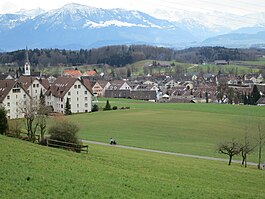Mettmenstetten
| Mettmenstetten | ||
|---|---|---|
 |
||
|
||
| Coordinates: 47°15′N 8°28′E / 47.250°N 8.467°ECoordinates: 47°15′N 8°28′E / 47.250°N 8.467°E | ||
| Country | Switzerland | |
| Canton | Zurich | |
| District | Affoltern | |
| Government | ||
| • Mayor | René Kälin | |
| Area | ||
| • Total | 13.01 km2 (5.02 sq mi) | |
| Elevation | 460 m (1,510 ft) | |
| Population (Dec 2015) | ||
| • Total | 4,659 | |
| • Density | 360/km2 (930/sq mi) | |
| Postal code | 8932 | |
| SFOS number | 0009 | |
| Surrounded by | Aeugst am Albis, Affoltern am Albis, Kappel am Albis, Knonau, Maschwanden, Obfelden, Rifferswil | |
| Website |
www SFSO statistics |
|
Mettmenstetten is a village in the district of Affoltern in the canton of Zürich in Switzerland.
The town took its name from being "In the middle". It was listed as being in the middle of two other locations (the exact identity of the locations have been lost in time). Additionally, people used to overnight at Mettmenstetten when they were traveling between Zurich and Luzern, as this town is about in the middle of the route.
Mettmenstetten is first mentioned in 1116 as Metemunstat. It is mentioned as Mettmonstetten in 1240 and as Metamonstetten or Methemonstettin in 1255.
Mettmenstetten has an area of 13.1 km2 (5.1 sq mi). Of this area, 67.9% is used for agricultural purposes, while 18.9% is forested. Of the rest of the land, 13.1% is settled (buildings or roads) and the remainder (0.1%) is non-productive (rivers, glaciers or mountains).
It is located about 11 minutes driving distance from the City of Zug, and 18 minutes from the City of Zurich. Affoltern is about 5 minutes north.
The municipality includes the village of Mettmenstetten, with the two core sections of Ober- and Untermettmenstetten as well as the other sections; Dachlissen, Eigi, Grossholz, Herferswil, Hübscheren, Rossau and Wissenbach. It is located an elevation of 460 m (1,510 ft).
Mettmenstetten has a population (as of 31 December 2015) of 4,659. As of 2007[update], 10.9% of the population was made up of foreign nationals. Over the last 10 years the population has grown at a rate of 18%. Most of the population (as of 2000[update]) speaks German (92.8%), with Serbo-Croatian being second most common ( 1.7%) and Italian being third ( 1.6%).
In the 2011 election to the National Council the most popular party was the SVP which received 30.50% of the vote. The next four most popular parties were the SPS (15.41%), the GLP (12.75%), the FDP (8.49%), and the GPS (7.19%).
...
Wikipedia




